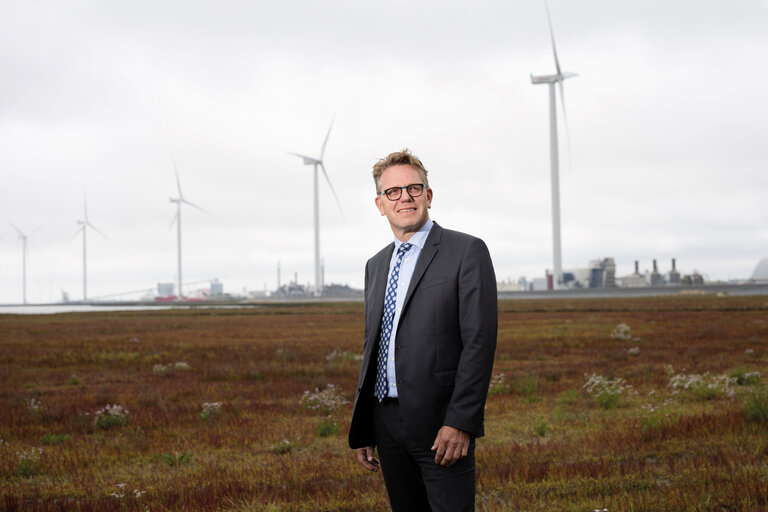
Hydrogen economy starts up in Groningen
In the midst of the coronavirus crisis, Groningen Seaports announced a surprising and optimistic message: industry in the northern Netherlands is ten years ahead of Paris’s climate goals. CEO Cas König talks about how they did it and the high ambitions for the coming years, especially in the field of hydrogen.
In 2019, the industrial cluster around the Eemshaven seaport and Delfzijl achieved a 54 percent reduction in CO2 compared to the base year of 1990. This means that they are now just one percent away from meeting the 2030 target. Cas König, CEO of Groningen Seaports, says: “The construction of a central steam pipeline, fed by Eneco's biomass power plant and EEW and Delesto's waste-to-energy plants, was a big success. With a central steam network, not every company has to produce its own steam, which led to a significant reduction in natural gas consumption. Moreover, we could reuse steam in many cases.
Working more energy efficiently
Groningen Seaports also initiated many energy efficiency projects within an umbrella program from the port authority. “We have said to the companies: we want to help you be more energy efficient. Then engineers visited all the companies in our area and offered them a free energy scan. They came up with solutions to drastically reduce energy consumption.”
Coupling opportunities
According to König, the program also yielded interesting additional findings: “These studies provided us with deep insight into the heart of the industry. We gained a lot of knowledge about their production processes. As a result, we also saw a lot of coupling opportunities, many more than we had ever thought possible before. Because, in addition to thermal exchange, good opportunities also seem to exist for reusing residual flows. One company’s waste can be a raw material for another.”
Hydrogen hub
But it certainly doesn't stop there, as far as Groningen Seaports is concerned. “We issued a report last year,” continues König, “in which we laid out a hydrogen agenda. This agenda included all the promising hydrogen plans we had collected. It contains no less than 33 hydrogen ideas for production, transport, and use. We have presented that as a whole to the Dutch Ministry of Economic Affairs and Climate, and the EU. As a result, we were recognized by the EU as the hydrogen hub of Europe, which included a subsidy of 20 million Euros to further support these ideas. That has inspired us to embark on a biomass investment agenda.”
Taking a bigger approach
König recognizes that both the investment and operational costs of green hydrogen production are high. “That is precisely why Groningen Seaports, along with Shell and Gasunie and with the support of the Province of Groningen, joined the NortH2 project. Because if we want to do this at a reasonable cost, we have to take approach hydrogen production on a larger scale We are now talking about the construction of a 10 GW offshore wind energy location, transport to the port, local hydrogen production with electrolyzers, and use both in local industries and further afield. This runs to Chemelot and Amsterdam via a pipeline and possibly even further, to Rotterdam and Antwerp.”
Groningen’s advantages
According to König, “his” region has at least five major advantages over other regions with similar initiatives. “Our first advantage is that there is a lot of open sea above the Eemshaven seaport. Secondly, we have a lot of space in the harbors to build the necessary electrolyzers. The third advantage is that we have the densest gas network in Europe. Fourthly, we have quite a few potential large-scale consumers of hydrogen here in the area. And finally, the possibility of storing hydrogen relatively close by, in the salt caverns in Zuidwending, exists. This will come in handy later to balance the electricity grid. Actually, we also have a sixth advantage: we have several universities and colleges in the region that specialize in applied research on hydrogen technology.”
Investment security
König knows that technological research is still desperately needed. “For comparison’s sake, I sometimes give the example that everyone knows how to make a cup of coffee, but when you need to make five thousand liters per hour, you really have to take a different tack. If we want to roll out the hydrogen economy successfully, we then face the challenge of needing to transform the entire chain at once. You're talking about generating, converting, storing, transporting, and using. For it to succeed, all parties involved must invest at around the same time. So if one says: “I'm going to invest in offshore wind energy,” then the next one says: “Okay, then I'm going to invest in electrolyzers now,” and the party after that: “Then I'm going to convert the gas grid for hydrogen now,” and the user: “Then I'm going to convert my plant from using natural gas to hydrogen now.” We also need the government involved in all this, both at the national and European level. They can provide investment security through tenders, subsidies, and permits. After all, this is how offshore wind energy became a success. You can easily copy that system.”
Economic growth
Groningen Seaports wants to be the driving force behind industrial sustainability. König: “The transition can make an enormous contribution to the economic growth of the northern Netherlands. Currently, we have CO2 emissions measuring 1.3 million megatons in this region. But we delivered savings of no less than 7 megatons. There are many initiatives going on here that are going to save a lot of CO2 in the chain. This can give a major boost to employment, prosperity, and well-being. We are ready for the hydrogen economy here, and as far as I'm concerned, it makes sense if it starts here.”
